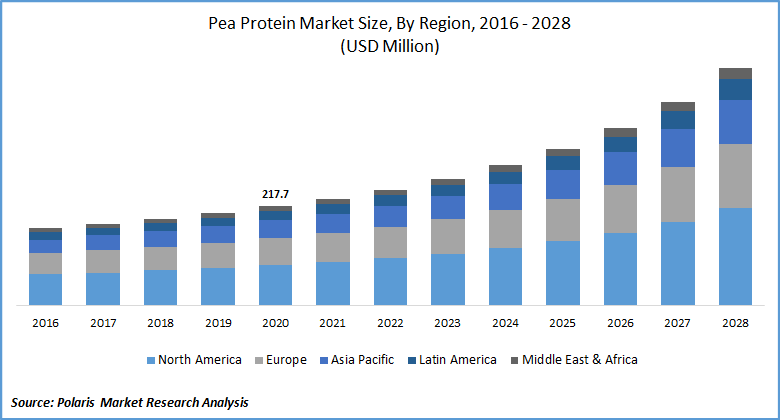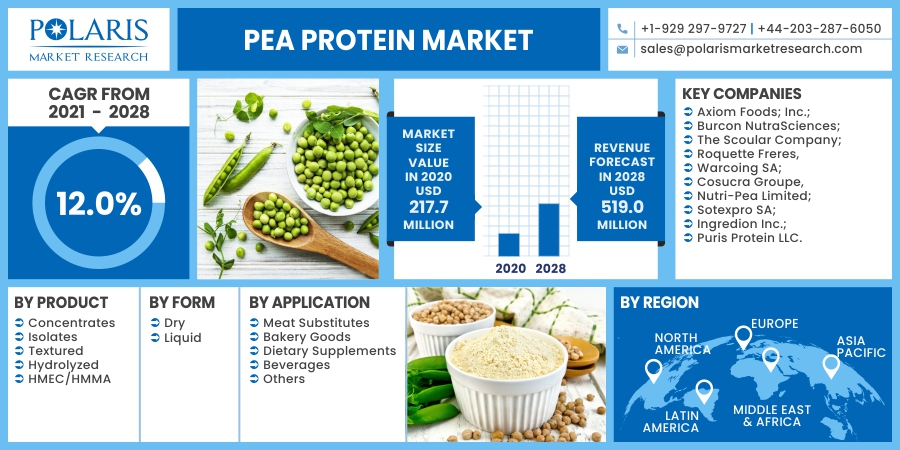
Pea Protein Market Share, Size, Trends, Industry Analysis Report, By Product (Concentrates, Isolates, Textured, Hydrolyzed, HMEC/HMMA); By Form (Dry, Liquid); By Application (Meat Substitutes, Bakery Goods, Dietary Supplements, Beverages, Others); By Regions; Segment Forecast, 2021 - 2028
- Published Date:Apr-2021
- Pages: 101
- Format: PDF
- Report ID: PM1859
- Base Year: 2020
- Historical Data: 2016-2019
Report Summary
The global pea protein market was valued at USD 217.7 million in 2020 and is expected to grow at a CAGR of 12.0% during the forecast period. Prominent factors responsible for the market growth include the applicability of products in dietary items, bakery goods, beverages, growing vegan population, and rising popularity of meat substitutes in the market.
 Know more about this report: request for sample pages
Know more about this report: request for sample pages
Pea protein has strong demand in adults seeking gluten-free products, and the people who are suffering from lactose intolerance or any other kind of metabolic disorder. The increasing importance of dietary supplements with enriched pea protein and concerns regarding meat allergies also favoring the market growth. Protein-fortified foods and pea protein powders are likely to fuel the market growth.

Know more about this report: request for sample pages
Pea Protein Market Report Scope
The market is primarily segmented on the basis of product, by form, by application, and geographic region.
|
By Product |
By Form |
By Application |
By Region |
|
|
|
|
Know more about this report: request for sample pages
Insight by Form
In 2020, the dry-based pea protein market segment accounted for the largest market revenue share. It is mostly available in dry powder form. Its use in processing of health supplements, bakery and meat products is likely to fuel the segment’s growth. Mostly, it finds application in analogues, meat extenders, and bakery sectors.
Liquid pea protein segment is projected to witness the lucrative growth rate over the study period. Its adoption is mainly driven with ease it blends with other processed foods. Moreover, significant consumption of sports drinks, other nutritional beverages in key developed countries such as Germany, France, and UK are also fueling the liquid pea protein segment’s growth prospects.
Insight by Application
In 2020, the dietary supplements market segment of pea protein industry accounted for the largest market share. Expansion of nutraceuticals in emerging countries such as China and India and rapidly evolving food processing industry. Most of the nutraceuticals consumed were due to a rapidly booming population with high disposable income-seeking higher living standards.
Fortified pea protein is primarily added in soups, energy powders, tablets, and protein bars to add nutritional value and provide health benefits to the fitness-seeking young generation to regulate blood sugar levels. Such associated benefits of pea protein are expected to make the segment prosper.
Rising awareness about nutritional diet coupled with a surge in demand for energy drinks projected to fuel the market growth for pea protein. The food industry across the globe is evolving through the rising population and changing lifestyle impacting positively segment growth of pea protein industry. The bakery items segment is estimated to be the second largest segment by market share revenue.
The rising cake and bakery industry are also expected to favor the segment’s growth prospects. The meat substitutes segment is projected to witness a lucrative growth rate over the pea protein study period. The rising vegan population, new textured food substitutes, and concerns over meat allergies are expected to boost the pea protein application segment growth.
Geographic Overview
North America pea protein market is the largest contributor to the revenue in the global market. Rising demand for gluten-free foods, advances in sports nutrition, and rising concerns over-read meat consumption positively influencing the region’s growth. A considerable rise in output by the import of machinery is projected to promote processed and baked food items, thereby, resulting in strong demand for pea proteins as a texturizing agent in meat and baked food items.
Europe is estimated to be the second-largest market for pea protein. Rising cases of metabolic disorders and growing consumer preference towards plant-based foods are expected to boost the demand in the region. However, stagnate food and beverage industry in the region due to rising cases of COVID-19 cases in key markets such as the UK, France, Italy, and Germany. Moreover, tough environmental regulations to limit output will restrain the region’s growth.
Asia Pacific is projected to witness a lucrative growth rate over the assessment period. This is primarily due to a significant rise in consumption of functional foods in key emerging economies of India, China, and South Korea. Moreover, the booming hotel and restaurant industry coupled with retail chains in supermarkets likely to play important role in promoting the region’s growth. Hence, a growth scenario for the food and supplement industry is projected to fuel the market demand for pea proteins.
Competitive Insight
The key players operating in the global market are Axiom Foods; Inc.; Burcon NutraSciences; The Scoular Company; Roquette Freres, Warcoing SA; Cosucra Groupe, Nutri-Pea Limited; Sotexpro SA; Ingredion Inc.; and Puris Protein LLC.
License and Pricing
Purchase Report Sections
- Regional analysis
- Segmentation analysis
- Industry outlook
- Competitive landscape
Connect with experts
Suggested Report
- Cellulose Acetate Market Share, Size, Trends, Industry Analysis Report, 2022 - 2030
- Thin Wafer Market Share, Size, Trends, Industry Analysis Report, 2022 - 2030
- Reclaimed Lumber Market Share, Size, Trends, Industry Analysis Report, 2021 - 2028
- Green and Bio Polyols Market Share, Size, Trends, Industry Analysis Report, 2022 - 2030
- Operating Room Integration Market Share, Size, Trends, Industry Analysis Report, 2022 - 2030

